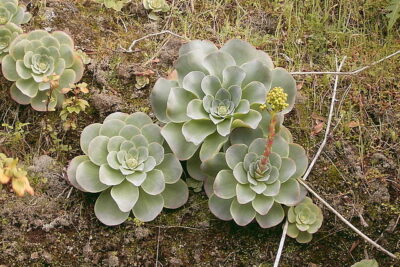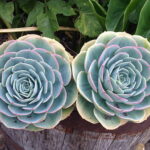
Can Fuzzy Kalanchoe Succulents Thrive Indoors?

Kalanchoe succulents are a popular choice among plant enthusiasts due to their vibrant colors and unique shapes. One particular variety that has gained attention is the fuzzy kalanchoe succulent. With its soft, velvety leaves and compact size, it is a charming addition to any indoor garden. However, many people wonder if these fuzzy kalanchoe succulents can thrive indoors or if they require specific conditions to grow successfully.
We will explore the characteristics of fuzzy kalanchoe succulents and discuss the care and maintenance they need to thrive indoors. We will delve into topics such as lighting requirements, watering schedules, and the ideal potting mix for these plants. Additionally, we will provide useful tips and tricks to keep your fuzzy kalanchoe succulents healthy and happy in an indoor environment. Whether you are a beginner or an experienced plant enthusiast, this article will provide valuable insights into growing fuzzy kalanchoe succulents indoors.
- Yes, fuzzy Kalanchoe succulents can thrive indoors
- Provide them with bright indirect light
- Water them sparingly, allowing the soil to dry out between waterings
- Use a well-draining potting mix specifically formulated for succulents
- Provide ample sunlight for your fuzzy Kalanchoe succulents
- Water your fuzzy Kalanchoe succulents sparingly
- Provide adequate humidity and temperature levels
- Fertilize your fuzzy Kalanchoe succulents occasionally
- Avoid overwatering, as this can cause root rot
- Maintain a temperature between 60-75°F (15-24°C)
- Fertilize occasionally with a balanced succulent fertilizer
- Prune off any dead or yellowing leaves
- Watch out for pests like mealybugs and treat them promptly
- Repot as needed to provide enough space for the plant to grow
- Enjoy the beautiful fuzzy foliage of your indoor Kalanchoe succulent
- Frequently Asked Questions
Yes, fuzzy Kalanchoe succulents can thrive indoors
Fuzzy Kalanchoe succulents, also known as Kalanchoe tomentosa, are a popular choice among indoor plant enthusiasts. These unique succulents feature soft, fuzzy leaves that have earned them their adorable nickname, "panda plants." If you're considering adding a fuzzy Kalanchoe succulent to your indoor plant collection, you'll be pleased to know that they can indeed thrive indoors with the right care and conditions.
Light Requirements
One of the key factors in ensuring the health and growth of your fuzzy Kalanchoe succulent is providing it with adequate light. These plants thrive in bright, indirect light, so placing them near a window that receives plenty of sunlight is ideal. However, be cautious of exposing them to direct sunlight for extended periods, as it may scorch their leaves.
Watering and Humidity
Like most succulents, fuzzy Kalanchoe plants have low water requirements. It's essential to allow the soil to dry out completely between waterings to prevent overwatering and root rot. A general rule of thumb is to water your Kalanchoe once every 1-2 weeks during the growing season and reduce watering frequency in the winter when their growth slows down.
In terms of humidity, fuzzy Kalanchoe succulents can tolerate average indoor humidity levels. However, they may benefit from a slight increase in humidity during dry winter months. Misting the leaves occasionally or placing a tray of water near the plant can help create a more humid environment.
 Choosing the Best Habitat for Thriving Succulents: Indoor or Outdoor?
Choosing the Best Habitat for Thriving Succulents: Indoor or Outdoor?Temperature and Environment
Fuzzy Kalanchoe succulents prefer warmer temperatures ranging from 60°F to 75°F (15°C to 24°C). They are not frost-tolerant, so it's crucial to keep them away from cold drafts or windows during the winter months. Additionally, these plants thrive in well-ventilated areas with good air circulation.
Soil and Fertilizer
When it comes to soil, fuzzy Kalanchoe succulents require well-draining soil to prevent waterlogged roots. A cactus or succulent mix that contains perlite or sand works best. As for fertilization, these plants have modest nutrient requirements. Using a balanced, diluted fertilizer once every few months during the growing season will suffice.
Propagation
If you want to expand your fuzzy Kalanchoe succulent collection or share them with friends, they are relatively easy to propagate. You can propagate them through leaf or stem cuttings. Simply remove a healthy leaf or stem, let it dry out for a few days, and then plant it in a well-draining succulent mix. Keep the soil lightly moist until new roots and growth appear.
With the right care and attention to their needs, fuzzy Kalanchoe succulents can thrive indoors, adding a touch of charm and whimsy to your indoor space. So, don't hesitate to bring home one of these adorable succulents and enjoy their fuzzy beauty all year round!
Provide them with bright indirect light
Fuzzy Kalanchoe succulents, also known as Kalanchoe Tomentosa or Panda Plant, are beautiful and unique houseplants. While they are primarily outdoor plants, they can thrive indoors if provided with the right conditions.
One of the most crucial factors for the successful cultivation of fuzzy Kalanchoe succulents indoors is providing them with bright indirect light. These plants prefer bright light, but direct sunlight can be too harsh and may scorch their leaves.
 Indoor Succulents: Thriving Tall Plants for Your Home
Indoor Succulents: Thriving Tall Plants for Your HomeTo ensure that your fuzzy Kalanchoe succulents receive the ideal amount of light, place them near a window that receives bright, filtered light. East or west-facing windows are usually the best options. If you have south-facing windows, it's advisable to use a sheer curtain or blinds to filter the intense sunlight.
If you notice that your succulent's leaves are stretching or leaning towards the light source, it's a sign that they are not receiving enough light. In this case, consider supplementing their light intake with artificial grow lights. LED grow lights are a popular choice, as they provide the necessary light spectrum without generating excessive heat.
Remember to rotate your fuzzy Kalanchoe succulents every few weeks so that all sides of the plant receive equal light exposure. This will prevent them from leaning or growing lopsided.
Overall, by providing your fuzzy Kalanchoe succulents with bright indirect light, you can create a favorable environment for them to thrive indoors and enjoy their unique charm.
Water them sparingly, allowing the soil to dry out between waterings
One of the key factors in successfully growing fuzzy Kalanchoe succulents indoors is to water them sparingly. These plants are native to arid regions and have adapted to survive in dry conditions. Overwatering can lead to root rot and other problems, so it's important to allow the soil to dry out between waterings.
When watering your fuzzy Kalanchoe succulents, it's best to use the "soak and dry" method. This means thoroughly watering the plant until water drains out of the bottom of the pot, and then allowing the soil to completely dry before watering again. The frequency of watering will depend on various factors such as the size of the pot, the temperature, and the humidity levels in your home.
 Can a Violet Queen Succulent Thrive Indoors? Tips for Indoor Care
Can a Violet Queen Succulent Thrive Indoors? Tips for Indoor CareIt's important to remember that these succulents are drought-tolerant plants and can survive periods of dryness. In fact, they prefer to be slightly underwatered than overwatered. By allowing the soil to dry out between waterings, you can help prevent the risk of root rot and ensure the overall health and longevity of your fuzzy Kalanchoe succulents.
Additionally, it's worth mentioning that the type of pot you use can also impact the water retention of the soil. Choosing a pot with good drainage holes and using well-draining soil specifically formulated for succulents can help facilitate proper water drainage and prevent waterlogged conditions.
Remember to always assess the moisture level of the soil before watering your fuzzy Kalanchoe succulents. You can do this by inserting your finger about an inch into the soil. If it feels dry, it's time to water the plant. However, if it still feels slightly moist, it's best to wait a bit longer before watering again.
By following these guidelines and watering your fuzzy Kalanchoe succulents sparingly, you can create the ideal conditions for these unique and beautiful plants to thrive indoors.
Use a well-draining potting mix specifically formulated for succulents
If you want to successfully grow fuzzy Kalanchoe succulents indoors, it is important to use a well-draining potting mix specifically formulated for succulents. These plants are native to arid regions and require a soil mixture that allows excess water to drain quickly and prevents the roots from sitting in wet soil.
Avoid using regular potting soil, as it retains moisture for longer periods of time and may cause the roots to rot. Instead, opt for a mix that contains a combination of materials such as perlite, coarse sand, and peat moss. This blend will provide the right balance of drainage and aeration for your Kalanchoe succulents.
Provide ample sunlight for your fuzzy Kalanchoe succulents
Fuzzy Kalanchoe succulents thrive in bright, indirect sunlight. Place them near a south-facing window where they can receive at least six hours of sunlight per day. If you don't have a suitable window, you can also use artificial grow lights to supplement the light requirements of your plants.
 Indoor or Outdoor: Choosing the Right Environment for Your Succulents
Indoor or Outdoor: Choosing the Right Environment for Your SucculentsRemember that succulents can get sunburned if exposed to direct sunlight for long periods, especially during the hottest hours of the day. If you notice your fuzzy Kalanchoe leaves turning brown or yellow, it may be a sign of sunburn. In such cases, provide some shade during the peak sunlight hours or move the plants to a location with filtered light.
Water your fuzzy Kalanchoe succulents sparingly
One of the most common mistakes when caring for fuzzy Kalanchoe succulents is overwatering. These plants have thick, fleshy leaves that store water, allowing them to withstand periods of drought. Therefore, it is crucial to water them sparingly.
Wait until the top inch of the soil feels dry before watering your Kalanchoe succulents. When watering, ensure that the water reaches the root zone and then allow the excess water to drain out completely. Avoid letting the plants sit in standing water, as this can lead to root rot.
During the winter months when the plants are in their dormant period, reduce watering frequency even further. Succulents require less water during this time, and overwatering can cause their roots to rot.
Provide adequate humidity and temperature levels
Fuzzy Kalanchoe succulents prefer low to moderate humidity levels. In most indoor environments, the humidity is usually sufficient for these plants. However, if you live in an extremely dry climate or during the winter when central heating can dry out the air, you may need to increase the humidity around your plants. You can do this by placing a tray of water near the plants or using a humidifier.
When it comes to temperature, fuzzy Kalanchoe succulents thrive in average room temperatures ranging from 60°F to 75°F (15°C to 24°C). Avoid exposing them to drastic temperature fluctuations, such as placing them near drafty windows or heating vents.
Fertilize your fuzzy Kalanchoe succulents occasionally
While fuzzy Kalanchoe succulents can survive without frequent fertilization, occasional feeding can promote healthier growth and blooming. Use a balanced, water-soluble fertilizer formulated for succulents and follow the instructions on the packaging for application rates.
 Can Succulents Survive Outdoors Year-Round?
Can Succulents Survive Outdoors Year-Round?It is important not to overfertilize, as this can lead to excessive leaf growth and a weaker overall plant structure. Fertilize your fuzzy Kalanchoe succulents during their active growing season, which is typically from spring to early autumn.
Avoid overwatering, as this can cause root rot
One of the most important things to remember when caring for fuzzy Kalanchoe succulents indoors is to avoid overwatering. These plants are native to arid regions and are adapted to survive in dry conditions. Overwatering can lead to root rot, which can be detrimental to the health of your plant.
When watering your fuzzy Kalanchoe succulent, it's best to follow the "soak and dry" method. This means thoroughly watering the plant until the water drains out of the bottom of the pot and then allowing the soil to dry out completely before watering again. The frequency of watering will depend on factors such as the size of the pot, the type of soil, and the environment in which the plant is kept.
It's important to note that these plants are more tolerant of underwatering than overwatering. If you're unsure whether your plant needs water, it's better to err on the side of caution and wait for the soil to dry completely before watering again.
Tip: To avoid the risk of overwatering, make sure your pot has drainage holes at the bottom to allow excess water to escape. This will prevent water from pooling at the bottom of the pot and potentially causing root rot.
Maintain a temperature between 60-75°F (15-24°C)
One of the key factors in successfully growing fuzzy Kalanchoe succulents indoors is maintaining the right temperature. These plants thrive in temperatures between 60-75°F (15-24°C), making them well-suited for indoor environments.
 Indoor Succulent Care: Expert Tips for Blue Succulents
Indoor Succulent Care: Expert Tips for Blue SucculentsIt's important to keep the temperature consistent and avoid extreme fluctuations. Avoid placing your fuzzy Kalanchoe succulents near drafty windows or doors where they may be exposed to cold drafts or hot blasts of air from heating vents.
During the winter months, when indoor heating may be running, it's important to monitor the temperature and consider using a humidifier to counteract the dry air. This will help prevent the leaves from drying out and maintain the plant's overall health.
Provide Adequate Light
While fuzzy Kalanchoe succulents can tolerate lower light conditions compared to other succulent varieties, they still require adequate light to thrive indoors. Place your plants in a bright location near a window that receives indirect sunlight for several hours a day.
If you notice your fuzzy Kalanchoe succulents stretching or leaning towards the light source, it may be an indication that they are not getting enough light. In this case, consider using a grow light or moving them to a sunnier spot.
Water Sparingly
Like all succulents, fuzzy Kalanchoe plants have adapted to survive in arid conditions, storing water in their leaves and stems. Therefore, it's crucial to water them sparingly to prevent root rot.
Allow the soil to dry out completely between waterings, and then water thoroughly until it drains out of the bottom of the pot. Avoid overwatering or letting the plant sit in standing water, as this can lead to root rot and other issues.
Fertilize Occasionally
Fuzzy Kalanchoe succulents do not require frequent fertilizing, but a light application of a balanced succulent fertilizer can help promote healthy growth. Apply the fertilizer according to the package instructions, usually once every few months during the growing season.
 Indoor or Outdoor: Maximizing Succulent Growth for Optimal Results
Indoor or Outdoor: Maximizing Succulent Growth for Optimal ResultsRemember to dilute the fertilizer to half or quarter strength to avoid overfeeding, as succulents are sensitive to excess nutrients.
Prune and Propagate
Pruning your fuzzy Kalanchoe succulents can help maintain their shape and encourage bushier growth. Use clean, sharp scissors or pruning shears to trim off any leggy or damaged stems. You can also remove any dead or yellowing leaves to keep the plant looking its best.
Additionally, fuzzy Kalanchoe succulents are easy to propagate. Simply cut a healthy stem or leaf, allow it to callous over for a few days, and then plant it in well-draining soil. Keep the soil lightly moist until new roots and growth appear.
By following these care tips and providing the right conditions, your fuzzy Kalanchoe succulents can thrive indoors and bring a touch of unique, fuzzy beauty to your home.
Fertilize occasionally with a balanced succulent fertilizer
When it comes to caring for fuzzy Kalanchoe succulents indoors, fertilization is an important aspect to consider. These unique succulents have a velvety texture and require occasional feeding to thrive.
One of the key elements to keep in mind when fertilizing fuzzy Kalanchoe succulents is to use a balanced succulent fertilizer. This type of fertilizer contains a mix of essential nutrients that cater specifically to the needs of succulent plants.
 Growing Curly Jade Succulents Indoors: Tips and Advice
Growing Curly Jade Succulents Indoors: Tips and AdviceIt is recommended to fertilize your fuzzy Kalanchoe succulents once every two to three months during the growing season, which is typically spring and summer. This will provide them with the necessary nutrients to support their growth and overall health.
When applying the fertilizer, make sure to dilute it according to the package instructions. Mixing it with water will prevent the fertilizer from overwhelming the plant's delicate root system. Overfertilizing can lead to root burn and other complications, so it's crucial to follow the recommended dosage.
Another important factor to consider is the timing of fertilization. It's best to fertilize your fuzzy Kalanchoe succulents in the morning or early evening when the temperatures are cooler. This allows the plants to absorb the nutrients effectively without being stressed by intense heat.
Remember to always read the instructions on the fertilizer packaging and follow them carefully. Each brand and type of succulent fertilizer may have specific guidelines, so it's essential to understand the recommended application rates and frequency.
By fertilizing your fuzzy Kalanchoe succulents occasionally with a balanced succulent fertilizer, you can ensure that they receive the necessary nutrients to thrive indoors. This will help promote healthy growth, vibrant foliage, and overall longevity for these charming and unique succulents.
Prune off any dead or yellowing leaves
When it comes to caring for fuzzy Kalanchoe succulents indoors, one important step is to regularly prune off any dead or yellowing leaves. This not only helps to maintain the overall appearance of the plant but also promotes healthier growth. Dead or yellowing leaves can be a sign of overwatering or lack of sunlight, so removing them will allow the plant to redirect its energy towards new growth.
 Can a Mother of Millions Succulent Thrive Indoors?
Can a Mother of Millions Succulent Thrive Indoors?Watch out for pests like mealybugs and treat them promptly
One of the challenges that indoor gardeners face when growing fuzzy Kalanchoe succulents is the presence of pests, particularly mealybugs. These tiny insects can cause significant damage to the plants if left untreated.
Mealybugs are known for their white, cotton-like appearance and are often found in the crevices and joints of the leaves. They feed on the sap of the plant, weakening it and causing stunted growth. If you notice any signs of mealybugs on your fuzzy Kalanchoe, it's important to take immediate action to prevent further infestation.
Here are some effective ways to treat mealybugs on your fuzzy Kalanchoe succulents:
- Isolate the affected plant: As soon as you spot mealybugs, it's crucial to isolate the infested plant from other healthy plants to prevent the pests from spreading. This will help contain the infestation and protect your other plants.
- Remove visible mealybugs manually: Carefully inspect the leaves, stems, and joints of your fuzzy Kalanchoe for any visible mealybugs. Use a pair of tweezers or a cotton swab dipped in rubbing alcohol to remove them. Be gentle to avoid damaging the plant.
- Apply natural remedies: There are several natural remedies you can use to control mealybugs. Mix a solution of water and mild dish soap and spray it directly on the affected areas. Alternatively, you can use a mixture of water and neem oil, which acts as a natural insecticide.
- Introduce beneficial insects: Another effective way to combat mealybugs is by introducing beneficial insects such as ladybugs or lacewings into your indoor garden. These natural predators feed on mealybugs and can help control their population.
- Maintain proper plant care: Keeping your fuzzy Kalanchoe succulents healthy and stress-free is key to preventing mealybug infestations. Ensure they receive adequate sunlight, proper watering, and well-draining soil. Healthy plants are less susceptible to pests and diseases.
By following these steps and staying vigilant, you can successfully treat and prevent mealybug infestations on your fuzzy Kalanchoe succulents. Remember to regularly inspect your plants for any signs of pests and take immediate action to keep your indoor garden thriving.
Repot as needed to provide enough space for the plant to grow
When it comes to caring for fuzzy Kalanchoe succulents, one important aspect to consider is their need for adequate space to grow. As these succulents have the potential to grow quite large, it is crucial to repot them as needed.
 Can Red Rose Succulents Thrive Indoors?
Can Red Rose Succulents Thrive Indoors?When you notice that your fuzzy Kalanchoe is outgrowing its current pot, it's time to give it a new home. Look for a pot that is slightly larger in size and has drainage holes to ensure proper water drainage.
To repot your fuzzy Kalanchoe, gently remove it from its current pot, being careful not to damage the roots. Shake off any excess soil and place it in the new pot, filling in the gaps with fresh succulent potting mix.
Remember to give your repotted Kalanchoe a good watering and allow the soil to dry out completely before watering again. This will help prevent overwatering and maintain optimal growing conditions for your succulent.
Provide ample sunlight for optimal growth
Another crucial factor in the successful indoor cultivation of fuzzy Kalanchoe succulents is providing them with ample sunlight. These plants thrive in bright, indirect light, so try to place them near a window that receives plenty of sunlight throughout the day.
If you notice that your succulent is not receiving enough light, you can supplement it with artificial lighting. LED grow lights are a popular choice among indoor gardeners as they provide the necessary light spectrum for optimal plant growth.
Keep in mind that while fuzzy Kalanchoe succulents enjoy sunlight, they are sensitive to intense heat. Avoid placing them in direct sunlight, especially during the hottest hours of the day, as this can lead to sunburn and damage to the plant.
Water sparingly, but don't let the plant dry out completely
Proper watering is essential for the health and survival of any plant, including fuzzy Kalanchoe succulents. These plants are adapted to arid conditions and have the ability to store water in their leaves.
When it comes to watering your fuzzy Kalanchoe, it's important to find the right balance. Overwatering can lead to root rot and other issues, while underwatering can cause the leaves to shrivel and the plant to become stressed.
A good rule of thumb is to water your fuzzy Kalanchoe thoroughly once the top inch of soil feels dry. However, avoid letting the plant sit in standing water as this can also lead to root rot. Always ensure that the pot has proper drainage to allow excess water to escape.
During the winter months, when the plant is in its dormant phase, reduce watering frequency. Fuzzy Kalanchoe succulents require less water during this time as they experience slower growth.
Monitor for signs of pests and diseases
Like any other plant, fuzzy Kalanchoe succulents are susceptible to pests and diseases. It's important to regularly monitor your plant for any signs of infestation or illness.
Common pests that may affect fuzzy Kalanchoe include mealybugs, aphids, and spider mites. If you notice any small insects, webbing, or discoloration on the leaves, take immediate action to prevent the infestation from spreading.
You can try using natural remedies such as neem oil or insecticidal soap to control pests. Alternatively, you can manually remove the pests using a cotton swab dipped in rubbing alcohol.
In addition to pests, keep an eye out for signs of diseases such as root rot or fungal infections. If you notice any unusual discoloration, wilting, or unusual growth patterns, investigate the issue and take necessary steps to address it.
Regularly inspecting your fuzzy Kalanchoe succulent and providing the appropriate care and treatment will help ensure its long-term health and vitality.
Enjoy the beautiful fuzzy foliage of your indoor Kalanchoe succulent
Indoor plants not only add a touch of green to your living space but also bring a sense of tranquility and freshness. If you're looking for a unique succulent to elevate your indoor garden, look no further than the fuzzy Kalanchoe succulent.
What is a fuzzy Kalanchoe succulent?
Kalanchoe is a genus of succulent plants that are native to Madagascar. Among the various species of Kalanchoe, the fuzzy Kalanchoe succulents are particularly eye-catching due to their velvety leaves. These plants, also known as Kalanchoe tomentosa or "panda plants," feature thick, oval-shaped leaves covered in soft hairs, giving them a fuzzy appearance.
Can fuzzy Kalanchoe succulents thrive indoors?
Yes, fuzzy Kalanchoe succulents can thrive indoors, making them an excellent choice for indoor gardening enthusiasts. These plants are known for their adaptability and ability to tolerate different light conditions, including low-light environments. However, they do prefer bright, indirect sunlight, so placing them near a window with filtered light is ideal.
Key tips for growing fuzzy Kalanchoe succulents indoors:
- Well-draining soil: Like most succulents, fuzzy Kalanchoe plants require well-draining soil to prevent their roots from becoming waterlogged. A mixture of succulent or cactus soil with perlite or sand works well.
- Watering: Allow the soil to dry out between waterings. Overwatering can lead to root rot and other issues, so it's best to water these plants sparingly.
- Temperature and humidity: Fuzzy Kalanchoe succulents prefer average room temperatures between 60-75°F (15-24°C). They can tolerate slightly lower temperatures during the winter months. These plants also appreciate a slightly more humid environment, so misting their leaves occasionally can be beneficial.
- Fertilization: Feed your fuzzy Kalanchoe succulent with a balanced, water-soluble fertilizer diluted to half strength during the growing season (spring and summer). Avoid fertilizing during the winter months when the plant is dormant.
- Pruning: Trim back any leggy or overgrown stems to maintain a compact and bushy appearance. You can propagate the trimmed stems to grow new plants.
Benefits of having fuzzy Kalanchoe succulents indoors:
- Aesthetically pleasing: The fuzzy leaves of Kalanchoe succulents add a unique texture and visual interest to your indoor space.
- Air purifying properties: Like many other houseplants, Kalanchoe succulents help improve indoor air quality by absorbing carbon dioxide and releasing oxygen.
- Low maintenance: Fuzzy Kalanchoe succulents are relatively easy to care for, making them a perfect choice for beginners or busy individuals.
- Stress relief: Being surrounded by nature and greenery has a calming effect on the mind, promoting relaxation and reducing stress.
So, if you're looking for a unique and low-maintenance succulent to brighten up your indoor space, consider adding a fuzzy Kalanchoe succulent to your collection. With their fuzzy leaves and adaptability to indoor environments, they are sure to delight both experienced plant enthusiasts and beginners alike.
Frequently Asked Questions
1. Can Fuzzy Kalanchoe Succulents Thrive Indoors?
Yes, fuzzy Kalanchoe succulents can thrive indoors as long as they receive ample sunlight and are planted in well-draining soil.
2. How often should I water my indoor fuzzy Kalanchoe succulent?
Water your indoor fuzzy Kalanchoe succulent sparingly, allowing the soil to dry out between waterings. Overwatering can lead to root rot.
3. Can fuzzy Kalanchoe succulents tolerate low light conditions?
No, fuzzy Kalanchoe succulents prefer bright light and require at least 4-6 hours of direct sunlight each day to thrive.
4. Do fuzzy Kalanchoe succulents require any special care?
Fuzzy Kalanchoe succulents are generally low-maintenance, but they do benefit from occasional fertilization during the growing season and regular pruning to maintain their shape.
If you want to read more articles similar to Can Fuzzy Kalanchoe Succulents Thrive Indoors?, you can visit the Indoor and Outdoor Care category.






You Must Read